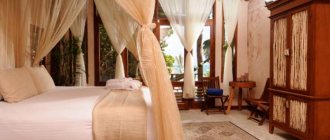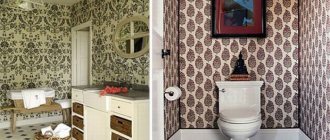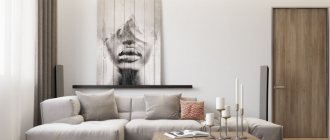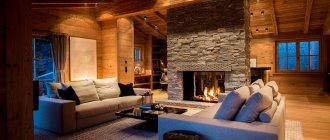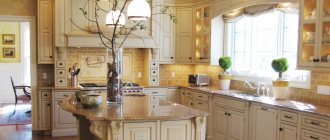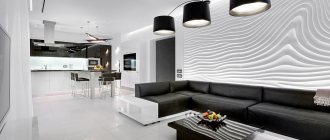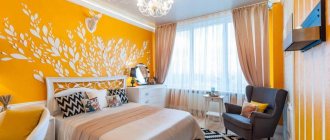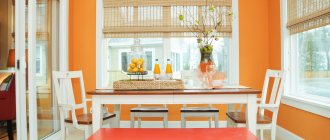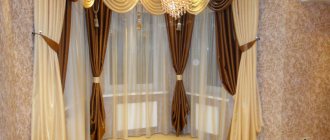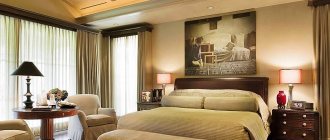Where are glass blocks used?
Glass blocks are distinguished by good sound-proofing and heat-saving properties, increased resistance to moisture and other external factors.
Application of material:
- For finishing walls or creating decorative inserts.
Decorative insert made of glass blocks Source homester.com.ua
- To create partitions and divide a room into functional zones.
- For finishing external walls of residential premises.
Glass blocks in a modern interior Source evrookna-mos.ru
- For zoning bathrooms, finishing shower walls.
The variety of surfaces, shapes and colors of glass blocks allows this material to be used for finishing rooms in various stylistic directions.
Most often, glass blocks are used to decorate the bathroom. The material is practical, resistant to high humidity, easy to care for, more reliable and durable compared to plasterboard.
Glass blocks in the bathroom Source pinterest.com
Walls made of glass blocks are suitable for decorating a shower stall.
In combined bathrooms, you can use material to divide a spacious room into functional zones. A straight or rounded wall made of multi-colored or single-color glass blocks can be used to decorate a shower stall or drain. You can also make a small partition between the toilet and the bathroom.
In a large room, you can separate the washing machine from the main area, creating a small room for washing and storing linen.
In the bathroom of a country house, you can cover the window with glass blocks with colored designs or stained glass; when exposed to sunlight, the window looks interesting and unusual.
Partitions and walls made of glass blocks are highly durable, but cannot replace load-bearing walls.
Area of application: bathroom
Glass blocks get along well with the urban styles of high-tech, loft, contemporary, minimalism and some variants of classics and baroque. In doses, you can introduce glass brick into a Scandinavian interior with a cold color scheme, but in “warm” eco-style and Provence, glass will most likely look alien.
There are several common ways to use glass blocks when decorating a bathroom. Each option can be used individually or in combination with others.
Walls
A wall made of glass blocks is a current solution for dark rooms. In this way, you can effectively decorate a divided bathroom and reduce energy costs. Replacing at least one blank wall or part of it with glass blocks will visually expand the space and improve illumination (due to the penetration of sunlight or artificial light from neighboring rooms).
In a small bathroom, it is better to build a glass wall from elements of the same shape and color. The color can repeat the main shade of the interior or create a bright contrast with it, but overall the wall should look uniform. Too colorful designs focus attention on the size of a small room. In large spaces there are no such restrictions; it is only advisable to take into account the general color palette.
Partitions
Glass blocks are an ideal solution for constructing partitions: the transparent or translucent structure of the material does not “eat up” the space, but does an excellent job of functional zoning. Partitions made of glass blocks are especially appropriate in a combined type bathroom. Glass blocks are laid in continuous rows or combined with other materials (brick, drywall). The side part of the partition can be designed flat, figured or stepped.
Window
Glass block windows are a fashionable and cost-effective choice. The design will cost much less than double-glazed windows, but will provide the necessary tightness. Glass blocks can be used to decorate only the perimeter of the window opening, but the option of filling the entire window is more practical and is used more often. The level of transparency of a glass block window is determined at the planning stage, taking into account the height of the opening above the floor level and the amount of natural light entering. It is advisable to make low-lying windows as opaque as possible.
Shower cabin
Very often glass blocks separate the shower area. Such fencing is more reliable than fragile solid glass partitions and more aesthetically pleasing than conventional curtains. Glass blocks can be used to make all the shower walls. Such designs look impressive, especially with the mutual reflection of the walls of the shower stall and the refraction of falling water drops. Rounded glass block railings are especially original and look most organic in the shower area.
In the living room
Glass blocks in the living room interior can be used to create full-fledged partitions.
Glass blocks in the bedroom interior Source remontbp.com
The use of glass elements in wall decor looks very interesting, stylish and unusual.
Decorating walls with glass blocks Source HappyModern.RU
The material is used to construct the base of a small coffee table or a full-fledged dining table.
Glass blocks in the living room Source remontbp.com
By decorating the walls with glass blocks, you can highlight the necessary area in the room.
Advantages of glass partitions
Developers of office and retail premises were the first to appreciate all the advantages of glass partitions and began to use them to zone huge open spaces. But since then they have confidently migrated into everyday life, combining aesthetics and functionality.
Glass partitions instantly make the interior unusual and individual. They harmoniously coexist with any other materials, from bare brick or concrete to valuable wood or natural stone. This is a bold and creative solution, which is always worked out strictly for a specific project.
With the help of partitions, the space becomes lighter, brighter and airier. This is especially true thanks to the fashion for minimalism, futurism and hi-tech. But depending on the decor, such designs will fit into any other style: neoclassical, contemporary, modern, art nouveau or loft.
Open layouts are in fashion, but many people still prefer to keep small, secluded corners. Glass partitions successfully balance between these concepts, because if desired, the glass can be frosted, opaque, covered with a decorative or mirror film. Installation of partitions in an apartment is simple and quick, without “wet” and dirty processes. You can deal with it yourself, and do it at any time, and not just during the process of cosmetic repairs. In this case, the configuration, height, width and other parameters can be absolutely any.
In the bedroom
Glass blocks in the bedroom interior create a calming and relaxing atmosphere due to their ability to diffuse and refract light.
A glass block partition will help create a cozy atmosphere in the sleeping area.
Glass blocks can be used to decorate a doorway or part of a wall.
Decorating a bedroom with glass blocks Source remoo.ru
A wall made of blocks located opposite the window will create a festive atmosphere in the room, especially if you choose colored glass blocks, such as green ones, for decoration.
Green glass blocks in the bedroom Source happymodern.ru
Glass partitions in the interior
Do you think that glass partitions are something of little use, unnecessary in new homes? We are willing to bet that such an interesting and practical decorative solution can be used in any room or interior.
Glass partitions in the kitchen
Along with tiles and acrylic, glass is one of the best materials for kitchen decoration. It does not absorb odor and is easily washed off from any stains, because even wine or juice does not penetrate the structure.
A sealed partition between the kitchen and the living room will prevent odors from spreading when the hood is weak. A glass structure between the dining area and the balcony will provide an influx of daylight and a picturesque view.
Glass partitions in the living room
Traditionally, the living room combines the most functions, which is why it is most often zoned in modern apartments and houses. Glass partitions are suitable even for small rooms to symbolically separate a relaxation area, workplace or creative workshop.
On the balcony, separated by a glass wall instead of brick or plasterboard, you can create a full-fledged greenhouse and admire it from any corner of the living room. And replacing the partition between the living room and kitchen with a translucent one visually enlarges and expands both rooms.
Glass partitions in the bedroom
In full-fledged separate bedrooms, partitions are rarely used. But even so, a compact mobile design will help separate the work area, wardrobe, dressing table or newborn crib.
In one-room apartments and studios, everything is more complicated, because it is difficult to completely separate the guest and sleeping areas. In this case, a glass partition will give the effect of privacy, but will not clutter up the space. And for a more expressive section of the territory, pay attention to tinting or frosted glass.
Glass partitions in the bathroom
In the bathroom, glass partitions traditionally solve two main problems: they protect a stationary shower stall and allow you to divide the room without reducing it visually. Glass goes well with tiles, sanitary ware, mirrors, acrylic and chrome parts, so it fits into the bathroom like it’s native.
Glass is not afraid of moisture, is easy to clean, does not become damp, does not deform and does not rust. A smooth coating does not create favorable conditions for the development of fungus or mold. It’s not for nothing that shelves, shower cabins and bathroom accessories are often made of glass.
Glass partitions in the hallway
The cramped hallways and narrow corridors of most modern apartments are hopelessly cut off from sunlight. The lack of space and windows is difficult to compensate for even with the most modern lighting system.
A glass stationary or sliding partition instead of a wall will solve both problems at once: it will lighten the interior and provide access to daylight. Most often, they are installed at the junction with the kitchen or living room, leaving but blurring the boundary between the rooms.
In the hall
In most cases, hallways have a small area; to visually enlarge the space, you can use light shades in the interior or decorate the corridor with glass blocks.
The door to the living room can be replaced with a beautiful arch made of glass blocks.
The floor and ceiling can also be finished with a strong material, such as blue. You can make a small table from glass blocks near the wall.
Floor and ceiling made of glass blocks Source lboz.ru
Adding glass blocks to your wall trim can help improve illumination in a poorly lit hallway.
Wall decoration with glass blocks Source roomester.ru
Wall made of glass blocks in the interior: pros and cons
Like any solution, a glass block wall has its advantages and disadvantages; how significant they are is up to you to decide.
Photo: Instagram @seves_glassblock
Photo: Instagram @seves_glassblock
Key benefits
1. Light transmission. You can build a thick, durable wall without depriving yourself of natural light.
2. Not viewable. The material transmits up to 90% of the sun's rays - and at the same time does not allow you to see what is happening behind it. This makes it suitable for decorating bedrooms, bathrooms and other private areas.
3. Air gap. There is air inside the “bricks”, which provides additional heat and sound insulation.
Photo: Studio11
Photo: Studio11
Photo: Studio11
Photo: Studio11
Photo: Instagram @sofia.architizm
Photo: Instagram @sofia.architizm
4. Moisture resistance. An excellent move - glass blocks in the interior of the bathroom and in other “wet” areas.
5. Easy to care for.
6. Eco-friendly. Glass is an environmentally friendly, recyclable material.
Photo: Instagram @obecoglassblocks
Photo: Instagram @obecoglassblocks
Design: Alex Gasca
Design: Alex Gasca
Photo: Instagram @anna_tiutina
Photo: Instagram @anna_tiutina
7. Durability. The wall will turn out to be solid - and will last for many years.
8. Visual lightness. Despite the solidity and heaviness, structures made of glass blocks in the interior look airy and uncluttered.
9. Expressive design. This wall does not require any additional finishing; it looks impressive and attracts the eye.
Photo: loft-kolasinski.com
Photo: loft-kolasinski.com
Design: Alex Gasca
Design: Alex Gasca
Photo: Instagram @jey.oh
Photo: Instagram @jey.oh
Main disadvantages
1. Weight. Each “brick” weighs from 2.5 to 4.3 kg, resulting in a rather heavy structure. In situations where it is important to monitor the load on the floors, this is a significant disadvantage.
2. Impossibility of pruning. When constructing a structure, you will have to focus on the dimensions of the elements.
3. No wall decor. Hanging a shelf or a picture on such a wall is an idea that is best abandoned.
Photo: Instagram @mybright_interior
Photo: Instagram @mybright_interior
Photo: Instagram @juhlhaus
Photo: Instagram @juhlhaus
Photo: Instagram @seves_glassblock
Photo: Instagram @seves_glassblock
4. Lack of air circulation. If you want to build a “breathable” partition, glass blocks are not your option.
5. Difficulty of construction. Working with the material requires professionalism.
Photo: Instagram @seves_glassblock
Photo: Instagram @seves_glassblock
Photo: Instagram @hyggehomeberlin
Photo: Instagram @hyggehomeberlin
Photo: Instagram @skladskla
Photo: Instagram @skladskla
6. Lack of ability to hide communications. If you need a wall that hides wiring or pipes, glass blocks are a poor choice.
7. Expressed style. The expressiveness of the material also has a downside: a wall made of glass blocks in the interior does not always look organic.
Photo: academymstudio.com
Photo: academymstudio.com
Photo: Instagram @seves_glassblock
Photo: Instagram @seves_glassblock
Photo: Instagram @pdmebelpenza
Photo: Instagram @pdmebelpenza
In the kitchen
Glass blocks are used more often in creating kitchen interiors. Glass material is used not only for finishing walls, window and door openings, but also for finishing a kitchen apron, decorating and zoning a room.
Wall decoration with glass blocks Source roomester.ru
Recently, glass blocks have been used to make table bases. This decor looks quite interesting and unusual.
Clear glass blocks pair well with white kitchen cabinetry or wood trim.
Wall decoration with glass blocks Source homester.com.ua
Qualities and advantages
Modern glass blocks are made from two parts glued together. Remaining hollow inside, they have the highest strength due to the special grooved shape along the edges.
Partitions made from this material can turn out to be very original in appearance, and they will also be distinguished by their reliability and immunity to external influences, humidity and temperature changes. The use of glass blocks with a matte surface will allow them to be used as decorative elements not only in living rooms, but also in bathrooms.
If such advantages as the unusual and stylish appearance of glass block partitions are visible even in the photo, then their other advantages are worth mentioning separately:
- they completely transmit light, but at the same time easily provide some visual security for the room;
- the material is not afraid of either moisture or mechanical damage;
- partitions can provide good sound insulation;
- the relatively high cost of glass blocks is compensated by the absence of the need for any additional finishing;
- the ability to create both regular straight and rounded or wavy partitions;
- ease of installation;
- the ability to beautifully combine with other types of finishing materials, creating a partition from several different segments;
- Thanks to the huge selection of colors and material textures, it is an excellent solution for interiors of any style.
Today, glass blocks are one of the most popular finishing materials, and partitions made from them are increasingly used by designers in the most luxurious and stylish interiors, as the examples presented in the photos speak very eloquently about.
What types of glass blocks are there?
With increasing demand for the material, manufacturers began to introduce new shapes, colors and textures of glass blocks. Square and rectangular shapes are more popular compared to round and triangular ones. Strong and durable material can also be in the form of diamond, wave, hexagon.
Colored glass blocks in the interior Source topdom.ru
Depending on the scope of use, they distinguish: construction and decorative glass blocks.
Glass blocks made in Germany and Italy are considered the most expensive and high quality. They are distinguished by their strict shapes and sizes, a wide palette of shades, and a well-polished surface.
Manufacturers from the Czech Republic make bright glass blocks by painting them from the inside. This method makes it possible to reduce the cost of production while maintaining the quality properties of the product.
The budget option includes materials produced in Russia and Poland. Manufacturers are expanding their range with a variety of shades and textures of blocks.
The lower price segment is occupied by glass blocks from Belarus and China.
Depending on the material from which glass blocks are made, there are:
- plastic - glass blocks inside special structures;
- glass blocks made of cellular glass.
Manufacturers make 2 main types of glass blocks: transparent and colored. When producing colored glass blocks, dyes are added to the mass before molding.
Depending on the surface, there are 4 types of glass blocks:
- Sanded, smooth, throughput is 85%.
- Matte, transmits 50% of light.
- Glossy, obtained by polishing.
- Embossed, can diffuse or direct light.
- Glass blocks with a pattern or pattern have a high cost due to the complexity of production.
- Glass blocks with inserts are usually created for a specific design project.
Interior design with glass blocks Source roomester.ru
Depending on the lighting qualities, the material is divided into: light-directing, light-diffusing and translucent glass blocks.
It is necessary to choose glass blocks for the interior design of a living space based on the chosen stylistic direction and color design.
Color solution
Partitions of any shape are assembled from glass bricks, which can be of different colors. Colorless glass blocks are the most popular, as they transmit the maximum color, and are also the most inexpensive. They will suit any interior, and if you change the design of the walls, you don’t have to change the partition.
To decorate colorless structures, decorative inserts made of plexiglass, colored, textured glass blocks or elements with decor made of stones, shells, and dried flowers inside are used. Decorative blocks with a drop pattern are often used for shower partitions.
Colored products have a wide selection of shades and reliefs. They allow you to create a dynamic and bright interior. The light transmittance of painted blocks is 35-50%, which determines their use for separating areas that require privacy.
Color blocks from different batches may have different shades, so it is recommended to purchase the required quantity with a small margin in case the elements are damaged during installation.
Glass bathroom partitions made from clear glass blocks can be decorated using artistic painting techniques. Drawings based on individual sketches can create a unique interior in the bathroom. The basic rule of decor is moderation.
Colorless glass blocks
Glass blocks with decorative elements
Colored glass blocks
Features of interior glass blocks
The material is resistant to moisture, high or low temperatures, and easily transmits light, allowing you to save energy. It is not difficult to maintain glass blocks in their original form: they are easily cleaned of dirt with a damp cloth. Glass blocks in the bathroom interior allow you to increase the space of the room due to the ability of the material to transmit light.
Interior design with glass blocks Source remontbp.com
But there are negative sides to using them. You cannot attach a shelf or any decoration to a glass block wall or partition. They cannot be cut, it is impossible to lay electrical wiring between them.
Wall decoration with glass blocks Source peregorodkainfo.ru
Glass block partitions cannot serve as a load-bearing wall.
Glass blocks in the interior Source roomester.ru
If you cover a window with glass blocks, the ability to ventilate the room will disappear. Double-glazed windows made from glass blocks will help cope with this problem.
Glass block finishing Source dekormyhome.ru
Glass loft partitions with advantages and disadvantages
Loft glass partitions are available in different versions.
Depending on the size of the room and personal preferences, you can choose:
- Solid;
- Cascade;
- Swing doors;
- Sliding doors;
- Partition-window;
- Mirror partition;
- Partition-rack;
- Book partition;
- Accordion partition, etc.
Each type has its own opening system, so choose the one that will be most convenient for you. The designer will advise the best option and help with the choice.
Advantages of using glass partitions in the interior:
- Preserving open space. Glass partitions do not deprive the room of air and volume, but at the same time create the illusion of full zoning. And the installation of sliding partitions makes it possible to transform the room depending on the situation, which is especially important for a small space.
- Natural insolation. The main advantage of glass is the possibility of light penetration. Therefore, glass partitions in a room with one window are also a way to add natural light to a dark part of the room. Or let natural light into a windowless room.
- Odor control. Glass partitions can retain odors and moisture, which is especially important when zoning the kitchen and living room or bedroom and bathroom with glass.
- Space saving. Glass partitions are much thinner than their counterparts made from other materials. Therefore, they are indispensable if you need to save space.
- Stylistic versatility. Glass looks light, modern and appropriate in any interior style. The only difference is in the presentation - the use of color, texture, originality of design.
- Wide possibilities for decoration. Glass has endless possibilities for decoration. It can be of any color, degree of transparency, glossiness and matteness, smoothness or roughness. You can put any image on it and highlight it with lighting. It all depends on the function performed and the style of the interior.
- Environmental friendliness. Glass is environmentally friendly. This is one of the safest materials for the home.
Disadvantages of using glass partitions in the interior:
- Fragility. Although modern glass that has undergone thermal post-processing acquires special strength - it becomes 5-7 times stronger than ordinary glass - and crumbles into non-sharp fragments, glass can still be broken.
- Special care. Glass requires some effort in care - it must be washed regularly, because dust will inevitably accumulate on it and fingerprints will appear. A sloppy appearance will negate all the advantages of a successful design solution.
- The illusion of privacy. Unlike a blank wall, glass partitions do not provide complete privacy and have high sound permeability.
- Not compatible with speaker systems. Glass partitions are not suitable for rooms with acoustic systems, as glass reflects sound and is subject to vibration. This will negate the effect of using special equipment.
Installation of glass block partitions
Creating structures from glass blocks is a simple process. Installation of glass block partitions includes the following steps:
- Determining the installation location of the partition.
- Preparing and cleaning the mounting surface. Using slats, you need to outline the boundaries of the base of the structure.
- Laying the first row of glass blocks.
- Installation of stainless steel reinforcing rod. It is not recommended to lay more than 3 rows of blocks per day, as the structure may warp.
- After the mixture has completely dried, you need to remove the crosses and protective film on the blocks and begin applying the grout mixture.
- After cleaning the partition and drying it completely, it is necessary to protect the structure from moisture by applying a waterproofing liquid.
Glass blocks in a modern interior Source www.gradnja.rs
Glass block laying technology
A glass block partition is a beautiful design and easy to construct. One person can handle its creation. Here it is important to know and follow the rules for installing glass block partitions in accordance with the chosen method - “wet” or “dry”.
Correct laying of glass blocks
To correctly lay glass bricks, you need to take into account the nuances of working with the material:
- The surface on which you plan to lay glass blocks must be completely flat and clean.
- The wall area should not be more than 15 square meters, otherwise the elements of the lower rows may crack due to significant load.
- A wall made of this material cannot be used as a load-bearing wall.
- The film protecting the glass blocks is removed only after the seams have been rubbed.
If you decide to use glass blocks to create partitions in the bathroom, it is better to use them to enclose the location of the old font, where all communications are already connected.
The base for a false wall must have a margin of load-bearing strength. If in doubt, reinforcements will need to be made using special metal structures.
Cement method of laying glass blocks
It is believed that creating a partition or ledge from glass blocks by laying them on a cement-sand mortar is the most economical. This process is called “wet”: it resembles bricklaying, only the glass blocks are not installed in a checkerboard pattern, but one above the other. Only a finely dispersed mixture can be used for the solution. Large fragments can damage the glass surface.
Using special glue will make the work even easier. Some compositions are produced colorless, which will preserve the ideal transparency of the false wall.
Identical seams between glass blocks are obtained using spacer crosses. If the bulkhead has a rounded configuration, then the crosses between the elements are installed only in the inner part of the rounding. On the outside, the seams will remain equal to each other, but will be larger than on the inside. Their size is affected by the rounding radius. The size of the joints in a rounded wall can be reduced by using “half” glass blocks. And the smaller the radius, the higher the need to use half-blocks.
To construct solid bulkheads of significant dimensions, it is necessary to assemble a frame base made of metal profiles, fixed to the floor, ceiling, or wall.
How to build a partition using the “wet method”:
- Mix a small amount of adhesive, enough to install three rows of glass blocks.
- Apply glue to all sides of the products. Between them, after installation, insert masonry crosses.
- After completing each row, lay reinforcing rods with a diameter of 4–6 mm on top. In the first row, also install them in the seams between the blocks so that they protrude above the masonry. This way they will fit into the seams of subsequent rows.
- Wait a day for the adhesive to completely harden.
- Repeat the cycles until the entire height of the partition is erected.
After the false wall is erected, the seams are rubbed down and the protective film is removed from the glass blocks. To close the connection between the partition element and the floor, a plastic plinth is used.
The use of this method is recommended for the construction of low bulkheads due to the fact that the first rows of blocks during the construction of high structures may crack.
Traditional method of laying glass blocks
In this case, the “dry” method of fastening glass blocks is used. They are fixed on special modular systems. This method allows you to quickly build completely smooth walls without using a plumb line or level.
The frame material is varied. These are plastic, wood, polyurethane, aluminum of various shades and textures.
Modular systems do not spoil the aesthetic appearance of the partition; on the contrary, they add an additional artistic effect to the design of the living room or bedroom.
Frame cells are made according to the size of glass blocks. During the work, constant checking of horizontal and vertical levels is not required, and the laying process progresses much faster.
The frame base is fixed to the wall, floor and ceiling using dowel nails or self-tapping screws. The blocks are fixed in the cells by using special rubber gaskets - seals or silicone sealants. The latter are used more often: the structure is stronger, since the blocks are glued into the frame. But when using rubber seals, the damaged element is easier to replace.
Installation is quite quick and can be completed even by an inexperienced builder. The advantages of this method are that the partition element can be moved if necessary.
Laying glass blocks with your own hands
If you decide to install a rectilinear volumetric partition made of glass blocks in the living room, hallway or bathroom, it is better to choose the “dry” method.
When designing a partition with a complex configuration, the cement method is chosen. The reinforcement bars will need to be bent to the desired shape.
For “wet” technology you will need:
- level;
- marker for marking;
- roulette;
- spacer crosses;
- wire cutters;
- drill:
- putty knife;
- tile drills.
You will also need a cement-sand mixture or glue, a container and a whisk for mixing, wire or fiberglass reinforcement.
A different set of tools and materials for creating a partition using “dry” technology with your own hands, for example, here you need a hammer drill, an angle grinder with a stone disc, seals or silicone sealant. If the module is wooden, you will additionally need a hacksaw with fine teeth and a screwdriver.
Before constructing the bulkhead, decide on its dimensions. They must correspond to the dimensions of the selected glass blocks - these elements cannot be filed. If there are discrepancies, it is better to purchase additional half-blocks of a suitable color.
In order not to make a mistake with the size and design, lay out the blocks in the desired order on the floor and draw a diagram indicating all sizes. Then make markings on the load-bearing surfaces, checking the verticality of the lines. After this, you can begin constructing the partition using the chosen method.
